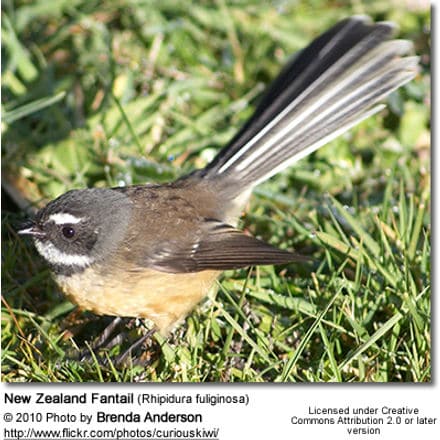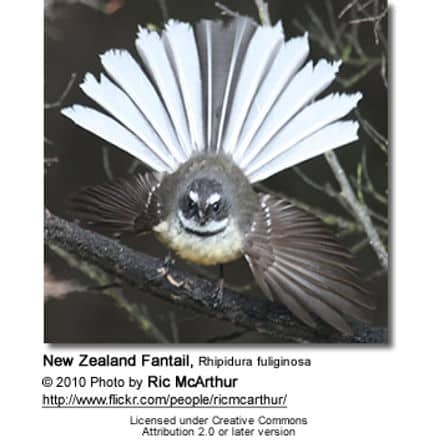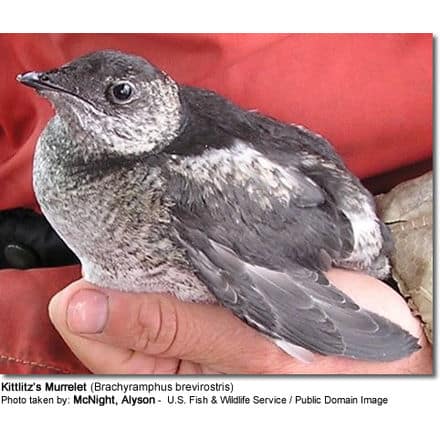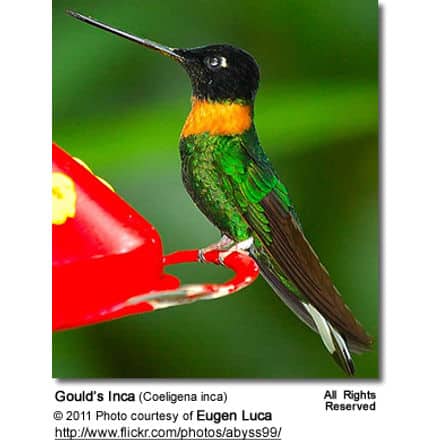New Zealand Fantails
The New Zealand Fantails (Rhipidura fuliginosa) is a common fantail that occurs naturally in New Zealand and nearby islands.
Its Maori names are P?wakawaka or T?wakawaka. Other common names refer to either physical or personality treats: White-shafted Fantail, Cranky Fan, Fanny and Mad Fan.
The black morph (genetic mutation) is referred to as the “Back Fantail” and the pied morph as Pied Fantail.
Their most identifying features are their agile in-flight twist and turns, and the constantly fanned tail.
The New Zealand Fantail was formerly grouped with the Australian Grey Fantail; however, due to distinct differences in vocalizations, most authorities now consider them separate species.

Alternate (Global) Names:
Czech: pávík popelavý … German: Graufächerschwanz, Neuseelandfächerschwanz … Danish: Grå Viftehale … Dutch: Grijze Waaierstaart … Finnish: tiaisviuhkamonarkki … French: Rhipidure à collier … Italian: Codaventaglio delle mangrovie … Japanese: haiiroougibitaki / ?????????? … Norwegian: Maoriviftestjert … Polish: wachlarzówka posepna … Slovak: vejárnik maorský … Spanish: Cola de Abanico de Collar Gris, Abanico Maorí … Swedish: Nya Zeelandsolfjäderstjärt
Distribution / Range
The New Zealand Fantail is native to the South Island of New Zealand, with subspecies occurring on the North Island, Chatham Islands and, formerly, on the Lord Howe Island.
They inhabit woodland and forest areas with dense vegetation layers, including trees, thick shrubs, logs and ground cover. They also visit densely planted gardens.
Subspecies and Distribution:
The recognized subspecies differ in the shade of grey of their plumages.
- South Island Fantail (Rhipidura fuliginosa fuliginosa – Sparrman, 1787) – Nominate Race
- New Zealand’s South Island, Stewart Island, and adjacent islands
- North Island Fantail (Rhipidura fuliginosa placabilis – Bangs, 1921
- Northern New Zealand: North Island and adjacent islands (Three Kings Island, Hen and Chickens Islands, Mokohinau Island, and islands of Little Barrier, Great Barrier, Mayor, Kapiti)
- Chatham Island Fantail (Rhipidura fuliginosa penita / penitus – Bangs, 1911)
- Chatham Islands (Chatham, Pitt, Southeast)
- [Norfolk Island Fantail] (Rhipidura fuliginosa pelzelni) – by some authorities considered a subspecies of Rhipidura albiscapa
- Range: Norfolk Island – vulnerable due to its limited range
- Lord Howe Island Grey Fantail (Rhipidura fuliginosa cervina – Christidis and Boles 1994; Higgins et al. 2006)
- Range: Only occurred on Lord Howe Island. Extinct under the Environment Protection and Biodiversity Conservation Act (1999) and listed as Presumed Extinct under the Threatened Species Conservation Act 1995. Became extinct between 1924 and 1928, likely due to predation by Black Rats (Hindwood 1940; Sharland 1929).
- ID: Averaged about 6 inches (15 cm) in length. Plumage below was pale creamy yellow with the throat being slightly paler than the rest. Head, neck and upper plumage grey. Long ,dark-grey tail with white tip. The bill was black, eyes black brown and the leg and feet grey-black.
Description
The New Zealand Fantails measure 5.5 – 6.7 inches (14 – 17 cm) in length, of which half is made up by its distinctively long tail, which is often displayed fanned out.
The plumage ranges from mid to dark grey or grey-brown above and yellowish-orange below. Some have a very dark plumaged and are referred to as “Black Fantails.” This morph makes up about 25% of South Island population and less than 1% of North Island birds. Those birds with unusual contrasting patches of colors on the plumage are called “Pied Fantails.”
They have a white throat, white “eyebrows” and two narrow wing bars. They have long , and either white-edged or entirely white outer tail feathers.
Gender ID: Males and females are alike.
Similar species
Willie Wagtail: Similar in appearance, but slightly larger.
Rufous Fantail: Has a distinctive rusty-red plumage on the back and brows.
Diet / Feeding
The New Zealand Fantails mostly feed on flying insects caught by chasing them around the foliage of trees or large shrubs. Insects are also sometimes taken off the ground or plants.
Behavior
This very active bird is not at all shy and is very comfortable around humans. This inquisitive creature will often approach an observer.
Calls / Vocalizations
The New Zealand Fantail makes rich, tinkling whistling – almost metallic – vocalizations that sound like “cheek” sometimes only as a single sound, but mostly repeated as a chattering.
Breeding
The New Zealand Fantails mostly breeds from August to March in the North Island, from September to January in the South Island, and from October to January on the Chatham Islands. The extinct Lord Howe Island subspecies usually bred from October through December.
Most males can reproduce when they are one year old; although some rare males commenced breeding within 1 to 2 months after fledging.
Both parents share the task of constructing the nest, incubating the eggs, and brooding and feeding the nestlings.
The compact, cup-shaped nests are made from decayed wood, moss, bark and plant fiber, lined with soft grasses and the structure of the nest is strengthened with large amounts of spider’s web. The nest has a long stem and the overall shape of the nest is reminiscent of that of a wine glass. The nest is usually situated in the forks of trees – typically between 6- 16 feet (2 – 5 meters) from the ground.
The clutch usually consists of 3 – 4 glossy, cream-white eggs with pale brown and grey spots. The eggs are incubated for about 14 days. The nestlings remain in the nest for another 12 days at which time they usually leave the nest. The parents continue to care for them for some time after fledging.
These fantails usually raise two or more broods per season. The construction of the second nest and incubation of the second brood may occur while the parents continue to feed the fledglings of their first brood.
Their nests are sometimes parasitized by the two species of cuckoo in New Zealand, which lay their own eggs into the nest of the Fantail for them to brood and raise as their own.






